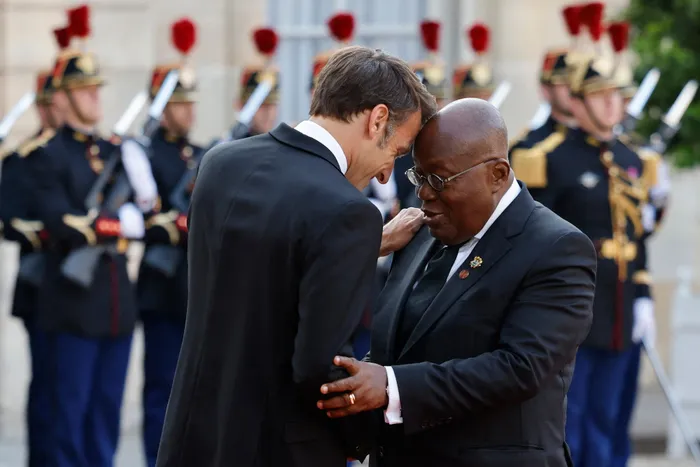World financial architecture failing Africa

Picture: AFP French President Emmanuel Macron greets Ghanaian President Nana Addo Dankwa Akufo-Addo before an official dinner at the Elysee Palace, on the sidelines of the New Global Financial Pact Summit, in Paris, this week. Dozens of global leaders gathered in Paris on June 22 for a summit to tease out a new consensus on international economic reforms to help debt-burdened developing countries.
By Akinwumi Adesina
UN Secretary-General António Guterres recently sounded an ominous alarm bell. The Sustainable Development Goals (SDGs), which aim to significantly reduce poverty around the world and create a better quality of life for all, are off track, he warned.
And so French President Emmanuel Macron called a global conference in Paris this month to address getting the 2030 SDG targets back on course.
As world leaders from Barbados to Kenya to Germany gather, there are seven things they must focus on. This blueprint for prosperity is too important to let slide. The global financial architecture is failing Africa and developing countries.
Before the sneak attack of the pandemic, progress in achieving the SDGs was mixed, with a $2.5 trillion annual SDGs financing gap for developing countries. Africa alone will need $1.3 trillion annually to achieve its sustainable development needs by 2030. Yet, the available financing is limited and insufficient to make up the difference and tackle global challenges, from food insecurity to rising debt.
According to the UN, some $3 trillion to $5 trillion per year needs to be mobilised to achieve the 2030 agenda for sustainable development. Our global financial architecture must decisively tackle climate change, which is devastating Africa’s economies. The African Development Bank estimates that Africa loses $7 billion to $15bn annually due to climate change, which is projected to rise to $45bn to $50bn annually by 2040.
To reverse effects such as water basins drying up across Africa’s Sahel, cyclones causing death and destruction to regions, and floods taking over whole city areas, Africa needs an average of $2.7 trillion by 2030. Such funding will be essential to support the continent’s climate resilience and a just energy transition. The current financial architecture must tackle global debt crises.
The structure of Africa’s debt has changed dramatically. While bilateral debt accounts for 25 percent of debt compared with 52 percent in 2000, commercial debt accounts for 43 percent of total debt, compared with 17 percent in 2000.
The expansion and fragmentation of the creditor base complicates debt resolution by the Bretton Woods Institutions. Debt resolution in Africa, especially outside of the Paris Club, has often been disorderly and protracted, with costly economic consequences.
To avert future debt crises, high debt resolution costs, and legal complications, the international community needs to push for enhanced transparency and global co-ordination among creditors. Global contingency financing has to start working for Africa. The Special Drawing Rights (SDR) issued by the International Monetary Fund provided significant resources to help countries deal with an ever-shrinking fiscal space.
However, of the $650bn of SDRs issued by the IMF in 2021, Africa received only $33bn, or 5 percent. More funding from this source could finance a plethora of development projects across the African continent – in education, health, agriculture, infrastructure and much more.
The African Development Bank and the Inter-American Development Bank have devised a solution for developed countries to provide long-term SDR loans to multilateral development banks (MDBs) in the form of hybrid capital, combined with a Liquidity Support Agreement. This will allow the MDBs to leverage the SDRs by 3 to 4 times to meet the greater financing needs.
The solution has now met the IMF Reserve Asset Status requirements in terms of creditworthiness and liquidity. This should be speedily implemented. Tackling development challenges calls for a change in the business models of multilateral financial institutions. Global pension funds and institutional investors, for example, have more than $145 trillion of assets under management.
Allowing Africa to access these massive resources will require significant changes to these businesses, from the deployment of more risk guarantee facilities, to the expanded use of synthetic securitisation to leverage balance sheets, to the transfer of some sovereign and non-sovereign assets to the private sector.
Enhanced leveraging of private sector financing for development is critical. Calls for multilateral development banks to do more in this regard are timely. The reality is that MDBs depend largely on callable capital of which only a small share is paid in. This limits effective risk capital that can be used to hedge and leverage private-sector financing at scale, due to strict prudential limits that all MDBs must respect to keep crucial triple-A credit ratings.
There should therefore be a significant increase in paid-in capital for multilateral development banks. Regional efforts should be promoted to tackle systemic risks in Africa. Africa is the only region of the world that does not have liquidity buffers to protect it against shocks, whether natural disasters, commodity price volatility or health crises.
The African Development Bank and the AU are working together to establish an African Financial Stability Mechanism allows countries to mutualise our funds and help avoid the spillover effects that come from global pandemics and other external shocks.
Other home-grown mechanisms would be welcome. Ultimately, what leaders gathered in Paris must recognise is that a re-engineered global financial architecture – one that is more responsive, inclusive and accountable – is what’s needed to support the accelerated development of the world.
This article was first published in Bloomberg. Adesina is president of the African Development Bank Group.